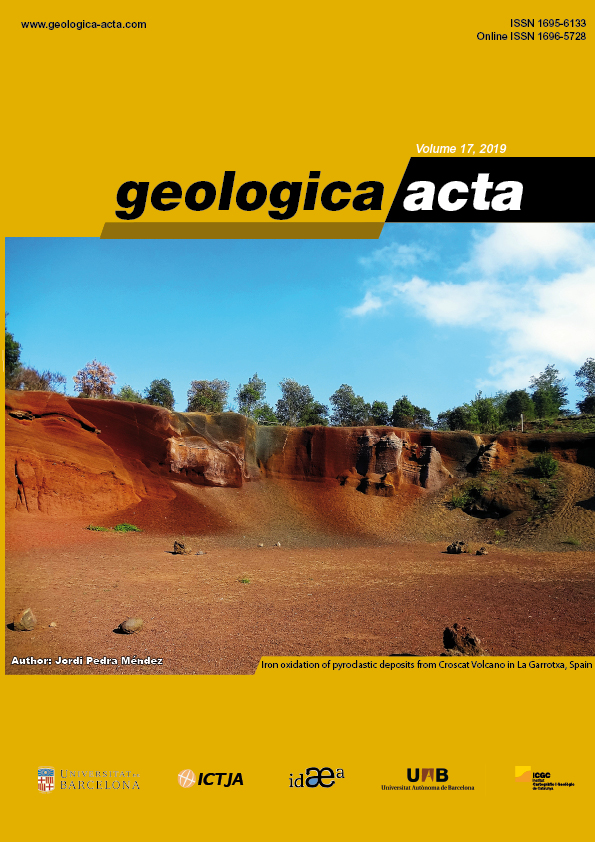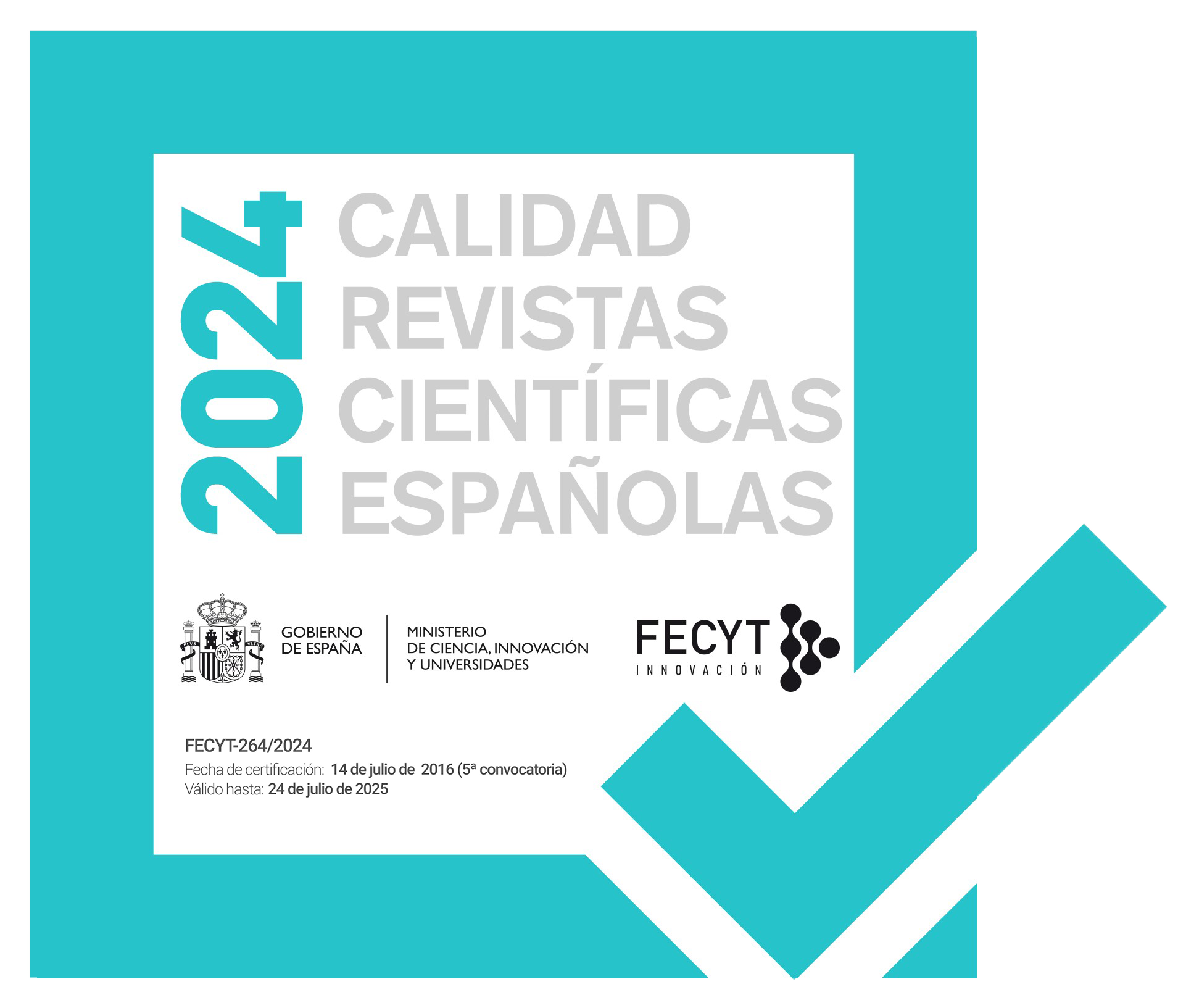Morphology, biostratigraphy, and evolution of Pliocene-Pleistocene diatoms Proboscia barboi and Proboscia curvirostris
DOI:
https://doi.org/10.1344/GeologicaActa2019.17.9Keywords:
Probosciaceae, Proboscis, Longitudinal ridges, Site U1340, QuaternaryAbstract
Proboscia barboi and Proboscia curvirostris are two important diatom biostratigraphic markers from the high latitudes of the North Pacific and North Atlantic Oceans, dating back to the Pliocene-Pleistocene time. This study analyzes the biostratigraphic events and describes the morphology of P. barboi and P. curvirostris, particularly the morphologic variations of the latter species, based on observations of samples of Core U1340A from the IODP Expedition 323 in the Bering Sea. In Site U1340, the First Occurrence of P. curvirostris is observed at 1.52Ma and its First Common Occurrence at 1.39Ma, where morphologic variations were found abundantly. The Last Occurrence of P. curvirostris was found at 0.33Ma, while P. barboi’s Last Occurrence is found at 0.67Ma. Based on the morphological similarity and known biostratigraphic distribution, previous authors have assumed that P. curvirostris descends from P. barboi, although this hypothesis is still in debate. At 1.39Ma P. curvirostris shows an increased size and thickness, which is typical of P. barboi, and some specimens display an incipient structure characteristic of P. curvirostris - the secondary spine. This morphology is intermediate between the two species and suggests an evolutionary transition from P. barboi to P. curvirostris. However, P. curvirostris already existed since 1.9Ma in the subarctic indicating that its speciation happened much earlier than 1.39Ma. Furthermore, since P. barboi co-occurs with P. curvirostris in the North Pacific, this evolutionary process was cladogenetic. Besides being evidence for a phylogenetic relationship, the abundant occurrence of intermediate forms at 1.39Ma may constitute a bioevent for a short time interval in the Bering Sea.
References
Abrantes, F., Gil, I., Lopes, C., Castro, M., 2005. Quantitative diatom analyses - A faster cleaning procedure. Deep-Sea Research Part I: Oceanographic Research Papers, 52(1), 189-198. https://doi.org/10.1016/j.dsr.2004.05.012
Akiba, F. 1986. Middle Miocene to Quaternary diatom biostratigraphy in the Nankai Trough and Japan Trench, and modified Lower Miocene through Quaternary diatom zones for middle-to-high latitudes of the North Pacific. Initial Reports of the Deep Sea Drilling Project, 87, 393-480. https://doi.org/10.2973/dsdp.proc.87.106.1986
Akiba, F., Yanagisawa, Y., 1986. Taxonomy, morphology and phylogeny of the Neogene diatom zonal marker species in the
middle-to-high latitudes of the North Pacific. Initial Reports of the Deep Sea Drilling Project, 87, 483-554. https://doi.org/10.2973/dsdp.proc.87.107.1986
Barron, J., 1985. Late Eocene to Holocene diatom biostratigraphy of the equatorial Pacific Ocean, Deep Sea Drilling Project
Leg 85. Initial Reports of the Deep Sea Drilling Project. US Government Printing Office, Washington, 85 (OCT), 413-456. https://doi.org/10.2973/dsdp.proc.85.108.1985
Barron, J.A., Gladenkov, A.Y., 1995. Early Miocene to Pleistocene diatom stratigraphy of Leg 145. Proceedings of the Ocean
Drilling Program, Scientific Results, 145, 3-19. https://doi.org/10.2973/odp.proc.sr.145.101.1995
Cande, S.C., Kent, D.V., 1995. Revised calibration of geomagnetic polarity time scale for the Late Cretaceous and Cenozoic.
Journal of Geophysical Research, 100, 6093-6095. https://doi.org/10.1029/94jb03098
Chappell, J., Omura, A., Esat, T., Mcculloch, M., Pandolfi, J., Ota, Y., Pillans, B., 1996. Reconciliation of late Quaternary sea levels derived from coral terraces Huon Peninsula with deep sea oxygen isotope records. Earth and Planetary Science Letters, 141, 227-236. https://doi.org/10.1016/0012-821x(96)00062-3
Expedition 323 Scientists, 2010. Bering Sea paleoceanography: Pliocene–Pleistocene paleoceanography and climate history
of the Bering Sea. IODP Preliminary Report, 323, https://doi.org/10.1002/2015pa002866
Expedition 323 Scientists, 2011. Site U1340. In: Takahashi, K., Ravelo, A.C., Zarikian, C.A., the Expedition 323 Scientists, 2011. Proceedings IODP 323. Tokyo, Integrated Ocean Drilling Program Management International, 1-81. https://doi.org/10.2204/iodp.sd.11.01.2011
Hajós, M., 1976. Upper Eocene and lower Oligocene Diatomaceae, Archaeomonadaceae, and Silicoflagellatae in Southwestern Pacific Sediments, DSDP Leg 29. Initial Reports of the Deep Sea Drilling Project, 35, 817-883. https://doi.org/10.2973/dsdp.proc.35.29chap1.1976
Hargraves, P.E., 1986. The relationship of some fossil diatom genera to resting spores. Proceedings of the Eighth International Diatom Symposium. O. Koeltz, Koenigstein, 67-80.
Hasle, G.R., Syvertsen, E.E., Steidinger, K.A., Tangen, K., Tomas, C.R., 1996. Identifying marine diatoms and dinoflagellates.
Academic Press, 598pp. https://doi.org/10.1016/b978-012693015-3/50006-1
Jordan, R.W., Ligowski, L., Nöthig, E.M., Priddle, J., 1991. The diatom genus Proboscia in Antarctic waters. Diatom Research,
1, 63-78. https://doi.org/10.1080/0269249x.1991.9705148 Jordan, R.W., Priddle, J., 1991. Fossil members of the diatom genus Proboscia. Diatom Research, 6(1), 55-61. https://doi.org/10.1080/0269249X.1991.9705147
Jordan, R.W., Saito, M., 1999. The genus Proboscia from the Thalassiosira yabei zone (middle-late Miocene) sediments of Hokkaido, Japan. In: Mayama, S., Idei, M., Koizumi, I. (eds.). Proceedings of the Fourteenth International Diatom Symposium. Tokyo (Japan), September 2-8, 1996. Koeltz Scientific Books, Koenigstein, 565-580
Jordan, R.W., Ito, R., 2002. Observations on Proboscia species from late Cretaceous sediments, and their possible evolution from Kreagra. In: John, J. (ed.). Proceedings of the 15th International Diatom Symposium. Perth (Australia), 28 September -2 October, 1998, A.R.G. Gantner Verlag K.G., 313-330.
Jordan, R.W., Ligowski, I.R., 2004. New observations on Proboscia auxospores and validation of the family Probosciaceae fam. nov. Vie et milieu, 54(2-3), 91-103.
Jouse, A.P., 1971. Diatoms in Pleistocene sediments from the northern Pacific Ocean. In: Funnell, B., Riedel, R. (eds.). The
micropaleontology of oceans. Cambridge University Press, 407-421.
Katsuki, K., Takahashi, K., 2005. Diatoms as paleoenvironmental proxies for seasonal productivity, sea-ice and surface circulation in the Bering Sea during the late Quaternary. DeepSea Research Part II: Topical Studies in Oceanography, 52(16-
, 2110-2130. https://doi.org/10.1016/j.dsr2.2005.07.001
Koç, N., Scherer, R.P., 1996. Neogene diatom biostratigraphy of the Iceland Sea Site 907. In: Thiede, J., Mclntyhre, A.M., Firth, J.V., Johnson, G.L., Ruddiman, W.F. (eds.). Proceedings of the Ocean Drilling Program, Scientific Results. Ocean Drilling Program, Texas A&M University, College Station, 151, 61-74. https://doi.org/10.2973/odp.proc.sr.151.108.1996
Koç, N., Labeyrie, L., Manthé, S., Flower, B.P., Hodell, D.A., Aksu, A., 2001. The last occurrence of Proboscia curvirostris in the North Atlantic marine isotope stages 9-8. Marine Micropaleontology, 41(1), 9-23. https://doi.org/10.1016/S0377-8398(00)00054-2
Koizumi, I., 1973. The late Cenozoic diatoms of Sites 183–193, Leg 19 Deep Sea Drilling Project. In: Creager, J.S., Scholl, D.W., P.R. (eds.). Initial Reports of the Deep Sea Drilling Project, 19(30), 805-855. https://doi.org/10.2973/dsdp.proc.19.130.1973
Koizumi, I., Tanimura, Y., 1985. Neogene latitude biostratigraphy of the middle latitude western North Pacific, Deep Sea Drilling Project Leg 86. Initial Reports of the Deep Sea Drilling Project, 86, 269-300. https://doi.org/10.2973/dsdp.proc.86.109.1985
Koizumi, I., Sato, M., Matoba, Y., 2009. Neogene diatoms from the Oga Peninsula, North-East Japan and ODP drilling cores in the Japan Sea. Palaeogeography, Palaeoclimatology Palaeoecology, 272, 85-98. https://doi.org/10.1016/j.palaeo.2008.11.007
Koizumi, I., 2010. Revised diatom biostratigraphy of DSDP Leg 19 drill cores and dredged samples from the subarctic Pacific and Bering Sea. JAMSTEC Report of Research and Development, 10, 1-23. https://doi.org/10.5918/jamstecr.10.1 Loseva, E., 1990. Are Both Rhizosolenia curvirostris Jouse and R. barboi Brun found in Pleistocene Sediments of Northeastern Europe? 11th International Diatom Symposium, 55-61.
Mann, D.G., 1999. The species concept in diatoms. Phycologia, 38(6), 437-495. https://doi.org/10.2216/i0031-8884-38-6-437.1
Onodera, J., Takahashi, K., Nagatomo, R., 2016. Diatoms, silicoflagellates, and ebridians at Site U1341 on the western slope of Bowers Ridge, IODP Expedition 323. Deep-Sea Research Part II: Topical Studies in Oceanography, 125, 8-17. https://doi.org/10.1016/j.dsr2.2013.03.025
Sancetta, C., Silvestri, S., 1986. Pliocene-Pleistocene evolution of the North Pacific Ocean-Atmosphere system, interpreted
from fossil diatoms. Paleoceanography, 1(2), 163-180. https://doi.org/10.1029/PA001i002p00163
Schrader, H.J., 1973. Cenozoic diatoms from the North-East Pacific, Leg 18. Initial Reports of the Deep Sea Drilling Project, 18, 673-797. https://doi.org/10.2973/dsdp.proc.18.117.1973
Stabeno, P.J., Schumacher, J.D., Ohtani, K., 1999. The physical oceanography of the Bering Sea. In: Loughlin, T.R., Ohtani, K.
(eds.). Dynamics of the Bering Sea: A Summary of Physical, Chemical, and Biological Characteristics, and a Synopsis of Research on the Bering Sea, North Pacific Marine Science Organization (PICES), University of Alaska Sea Grant, AKSG-99-03, Fairbanks, Alaska, USA, 1-28
Stroynowski, Z., Ravelo, A.C., Andreasen, D., 2015. A Pliocene to recent history of the Bering Sea at Site U1340A, IODP Expedition 323. Paleoceanography, 30(12), 1641-1656. https://doi.org/10.1002/2015pa002866
Stroynowski, Z., Abrantes, F., Bruno, E., 2017. The response of the Bering Sea Gateway during the Mid-Pleistocene Transition. Palaeogeography, Palaeoclimatology, Palaeoecology, 485, 974-985. https://doi.org/10.1016/j.palaeo.2017.08.023
Takahashi, K., Jordan, R., Priddle, J., 1994. The diatom genus - in Subarctic Waters. Diatom Research, 9(2), 411-428. https://
doi.org/10.1080/0269249X.1994.9705317
Takahashi, K., 2005. The Bering Sea and paleoceanography. DeepSea Research Part II: Topical Studies in Oceanography, 52(16- 18), 2080-2091. https://doi.org/10.1016/j.dsr2.2005.08.003
Takahashi, K., Ravelo, A.C., Zarikian, C.A., 2011. IODP Expedition 323 - Pliocene and Pleistocene paleoceanographic changes
in the Bering Sea. Scientific Drilling, 11, 4-13. https://doi.org/10.2204/iodp.sd.11.01.2011
Teraishi, A., Suto, I., Onodera, J., Takahashi, K., 2016. Diatom, silicoflagellate and ebridian biostratigraphy and paleoceanography in IODP 323 Hole U1343E at the Bering slope site. Deep-Sea Research Part II: Topical Studies in Oceanography, 125, 18-28. https://doi.org/10.1016/j.dsr2.2013.03.026
Tréguer, P.J., De La Rocha, C.L., 2013. The world ocean silica cycle. Annual Review of Marine Science, 5(1), 477-501. https://doi.org/10.1146/annurev-marine-121211-172346
Tsukazaki, C., Ishii, K.I., Saito, R., Matsuno, K., Yamaguchi, A., Imai, I., 2013. Distribution of viable diatom resting stage cells in bottom sediments of the eastern Bering Sea shelf. Deep-Sea Research Part II: Topical Studies in Oceanography, 94, 22-30. https://doi.org/10.1016/j.dsr2.2013.03.020
Yanagisawa, Y., Akiba, F., 1998. Refined Neogene diatom biostratigraphy for the North-West Pacific around Japan, with an introduction of code numbers for selected diatom biohorizons. Journal of the Geological Society of Japan, 24(6), 395-414. https://doi.org/10.5575/geosoc.104.395
Downloads
Published
Issue
Section
License
Copyright (c) 2019 Geologica Acta

This work is licensed under a Creative Commons Attribution-ShareAlike 4.0 International License.
Copyright
Geologica Acta is the property of the UB, GEO3BCN, IDAEA and UAB. Geologica Acta must be cited for any partial or full reproduction. Papers are distributed under the Attribution-Share Alike Creative Commons License. This license allows anyone to reproduce and disseminate the content of the journal and even make derivative works crediting authorship and provenance and distributing possible derivative works under the same or an equivalent license.
Author Rights
Authors retain the copyright on their papers and are authorized to post them on their own web pages or institutional repositories. The copyright was retained by the journal from the year 2003 until 2009. In all cases, the complete citation and a link to the Digital Object Identifier (DOI) of the article must be included.
The authors can use excerpts or reproduce illustrations of their papers in other works without prior permission from Geologica Acta provided the source of the paper including the complete citation is fully acknowledged.




